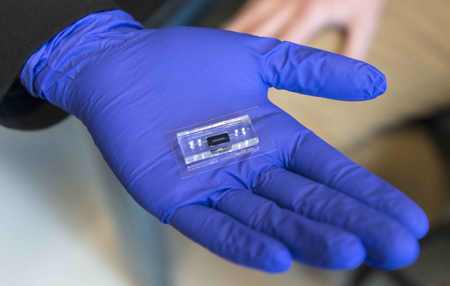Rochester Institute of Technology and University of Minnesota Researchers Bridge Biology and Computing with Processing in DNA Storage
Designed microfluidic IC to perform complex operations through artificial neural network computations on data stored in DNA
This is a Press Release edited by StorageNewsletter.com on June 26, 2024 at 2:01 pmFrom Rochester Institute of Technology
An engineering researcher at Rochester Institute of Technology has discovered the means to process data using DNA.
Microfluidic devices being built in RIT engineering laboratories
are being explored as new options for data storage on DNA.
RIT researchers have discovered the means to bridge biology and data.
Amlan Ganguly, computer engineering department head, RIT’s Kate Gleason College of Engineering, and researchers at the University of Minnesota, designed a microfluidic integrated circuit to perform complex operations through artificial neural network computations on data stored in DNA.
Their biocomputing design is a breakthrough that builds on innovative DNA engineering and computing system advances. While the research is in its infancy, the research team’s work today can lay the foundation to store the huge amounts of data generated by millions of personal and commercial tech devices. More robust storage capacity could improve archival data searches and forensics or medical sciences and biomedical applications where computing functions must be live-tissue compatible.
“We are in the age of big data that needs to be stored somewhere. We don’t think that more data centers are the answer, or even the best answer. Each data center requires the equivalent of a city block of power. Building, maintaining, and operating more traditional data centers is not sustainable,” said Ganguly, who added data stored on DNA is a largely unexplored area of research. “DNA is excellent at storing information, in fact, it is much better than the electronic modes of memory because it is about 3-to-6 orders of magnitude more compact than most memory hardware that we have; it is also much more reliable and durable.”
Results from the study were published in PLOS One Journal in the fall.
DNA and computing have several common functions: sequencing, or reading data, and synthesizing, or writing data. By beginning to manipulate materials at the molecular level, researchers are developing ways to decrease the electronics aspect of tech storage to increase use of biocompatible and highly compact storage and processing systems.
“We proposed to represent numbers through concentrations of solutions containing specifically manipulated DNA molecules and computing operations as manipulation of DNA molecules – operations like addition and multiplication and other non-linear functions necessary for network computations can be performed. That is the bridge from storage to computation and using DNA as a vehicle to do the computation,” Ganguly said.
The researchers are designing a prototype microfluidic system, a lab-on-chip device. It is a miniaturized system that can provide the output of an artificial neural network, which is a basic artificial intelligence algorithm. The microfluidic device functions as both a sensor and mini-computer processor consisting of a series of small channels with embedded nanotechnology sensors to separate, detect, and attract molecules in liquid samples.
Ganguly’s team is building a larger-scaled microfluidic device with the help of students in the engineering college’s senior design program. A larger model will help visualize the functions that the team is trying to achieve. Eventually, the development of a new computing structure may have additional environmental benefits.
“A computer made out of this DNA substrate is going to be far more sustainable than the traditional electronics we have now,” he said.
Article: Neural network execution using nicked DNA and microfluidics
PLOS One Journal has published an article written by Arnav Solanki, Department of Electrical and Computer Engineering, University of Minnesota Twin-Cities, Minneapolis, MN, United States of America, Zak Griffi, Purab Ranjan Sutradhar, Karisha Pradhan, Caiden Merritt, Amlan Ganguly, Department of Computer Engineering, Rochester Institute of Technology, Rochester, NY, United States of America, and Marc Riedel, Department of Electrical and Computer Engineering, University of Minnesota Twin-Cities, Minneapolis, MN, United States of America.
Abstract: “DNA has been discussed as a potential medium for data storage. Potentially it could be denser, could consume less energy, and could be more durable than conventional storage media such as hard drives, solid-state storage, and optical media. However, performing computations on the data stored in DNA is a largely unexplored challenge. This paper proposes an integrated circuit (IC) based on microfluidics that can perform complex operations such as artificial neural network (ANN) computation on data stored in DNA. We envision such a system to be suitable for highly dense, throughput-demanding bio-compatible applications such as an intelligent Organ-on-Chip or other biomedical applications that may not be latency-critical. It computes entirely in the molecular domain without converting data to electrical form, making it a form of in-memory computing on DNA. The computation is achieved by topologically modifying DNA strands through the use of enzymes called nickases. A novel scheme is proposed for representing data stochastically through the concentration of the DNA molecules that are nicked at specific sites. The paper provides details of the biochemical design, as well as the design, layout, and operation of the microfluidics device. Benchmarks are reported on the performance of neural network computation.“















 Subscribe to our free daily newsletter
Subscribe to our free daily newsletter

